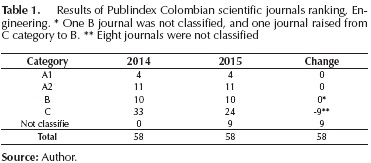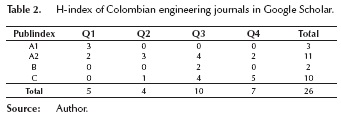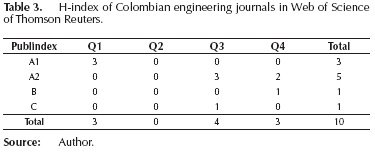Services on Demand
Journal
Article
Indicators
-
 Cited by SciELO
Cited by SciELO -
 Access statistics
Access statistics
Related links
-
 Cited by Google
Cited by Google -
 Similars in
SciELO
Similars in
SciELO -
 Similars in Google
Similars in Google
Share
Ingeniería e Investigación
Print version ISSN 0120-5609
Ing. Investig. vol.35 no.3 Bogotá Sept./Dec. 2015
Editorial
Ranking of Colombian scientific journals: Engineering case
Visibility and impact are the current measures for any scientific publication. Journals are not exceptions. Colombia has positioned several publications within the international standards. In this editorial note I would like to present a short view about the Colombian engineering journals.
In Colombia, Colciencias has proposed and employed the Publindex ranking model to rate all Colombian scientific journals. The last two calls for rating journals yielded, for the 58 Colombian engineering journals, the following results:
The first ranking results refer to the first update of 2014 Publindex qualification, and the second column refers to the second update of 2014 Publindex qualification1. Fifteen engineering scientific journals have been positioned as the leading publications in Colombia; Ingeniería e Investigación is among the four most highly rated engineering journals in the country, rated A1.
It would be interesting to see how the international recognition of the 58 Colombian journals looks like, taking into account international data bases.
There are different indicators to rank journals, such as: h-index, Journal Citation Report - JCR of Thomson Reuters, SciMago Journal Ranking -SJR of Scopus, SciELO Citation Index, etc. The h-index has also been employed even though it does not provide suitable information to qualify a journal impact, but it does provide a vague idea of how the journals are visible in the corresponding data base. In this editorial note the h-indices of the 58 Colombian engineering journals are compared according to their appearance in international data bases.
Let us first check Google Scholar2. This data base does not provide any acceptable ranking tools, but it provides an idea of how visible the publications are. Google Scholar has publicly provided the h-index, based on the last fi e years, and the median of the h-index for the same period. Twenty six (26) Colombian journals, among the engineering scientific publications, appear in Google Scholar. If the h5 index is used, the quartiles have the following results: Q1 = 12.0, Q2 = 5.0, Q3 = 4.0 and Q4 = 2.3. In order to compare the results with the Publindex ranking, the following table summarizes a cross classification
If the Web of Science Thomson Reuters ranking is employed, which uses the Journal Citation Report - JCR accesible under ISI Web of Knowledge3, ten (10) Colombian engineering journals are listed. The WoS data base also provides the h-index. The next table shows the results of h-index for WoS. The corresponding quartiles are: Q1 = 6.0, Q2 = 2.8, Q3 = 2.0 and Q4 = 1.3.
The last data base is Scopus4, where there are only four Colombian journals. The quartiles for the h-index are: Q1 = 7.0, Q2 = 4.8, Q3 = 3.5 and Q4 = 2.8.
SciELO is another important database, but in the moment of preparing this note the h-indices were not available.
All A1 ranked Colombian journals are visible in all international databases. The highest recognized databases, Scopus and Web of Science, include only A1 and A2 Colombian journals, while Google Scholar and SciELO also include some B and C rated journals. Lower rated journals are not visible within these databases because the inclusion in Scopus and Web of Science require more demanding and difficult processes.
From the previously presented data, a question arises: Which data base should be used to measure the international impact of Colombian journals? Of course, the more renowned and acknowledged databases would be the ideal space to be ranked and positioned, but the difficulties related to index journals do not only respond to demanding criteria. The Colombian scientific production is, in a significant amount, related to local problems, which are not always interesting to international researchers. Thus, even if the journals are indexed, the citation is rather low. Hence, a second question arises: Are Colombian journals prone to be indexed within regional databases? If this logic was to be employed, the impact of Colombian scientific productivity would be rated according to the actual interest of neighbor and national researchers, but in the long term it could lose the chance of improving and being competing with other journals outside our continent.
The discussion is still open and the contributions of all researchers, professors and professionals of engineering are required.
The Editorial Board of Ingeniería e Investigación sincerely expects this new number to be useful and interesting to all our readers. Once again we thank all authors and readers for their invaluable contributions.
Notes
1 http://publindex.colciencias.gov.co:8084/publindex/EnIbnPublindex/resultados.do
2 Consulted in October 2015. https://scholar.google.com.co/citations?hl=es&view_op=search_venues&vq=ingenieria+e+investigacion
3 Consulted in November 2015. http://adminapps.webofknowledge.com.ezproxy.unal.edu.co/JCR/JCR?wsid=1CMKtVkvfdHTIZxjsGz&ssid=&SID=1CMKtVkvfdHTIZxjsGz&SID=1CMKtVkvfdHTIZxjsGz
4 http://www.scopus.com.ezproxy.unal.edu.co/search/form.url
Andrés Pavas
Assistant Professor Electrical and Electronic Engineering Department
Director Ingeniería e Investigación Journal
Universidad Nacional de Colombia.











 text in
text in 




